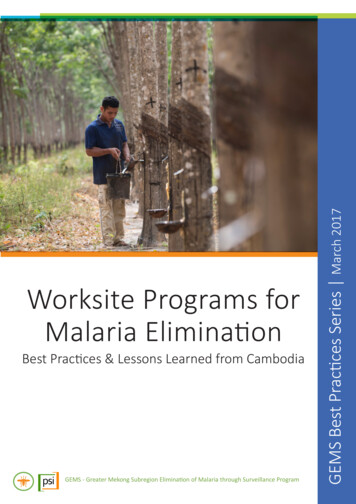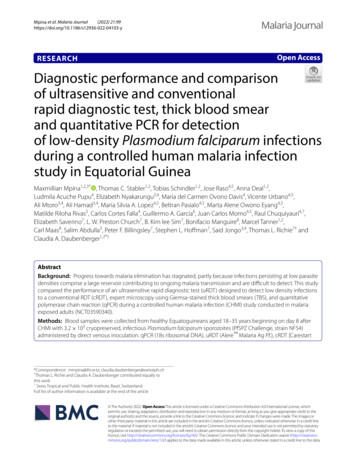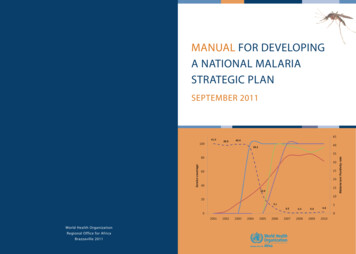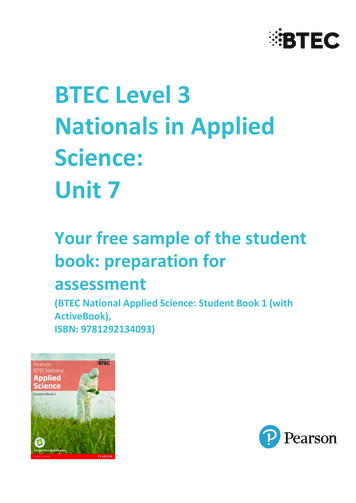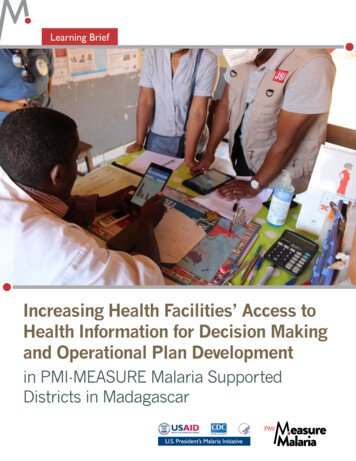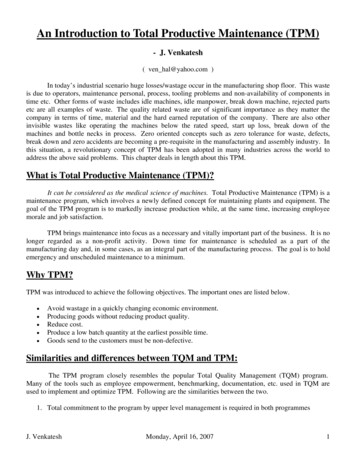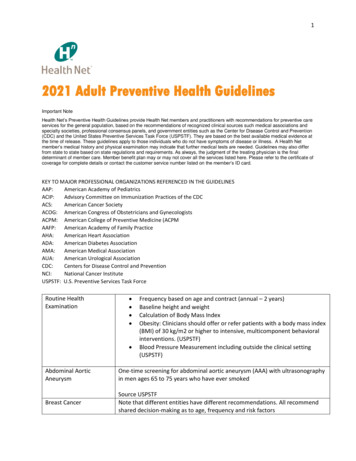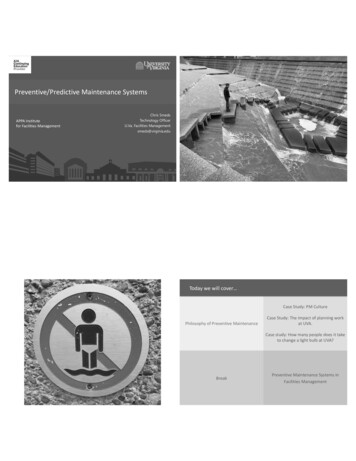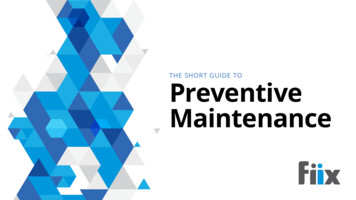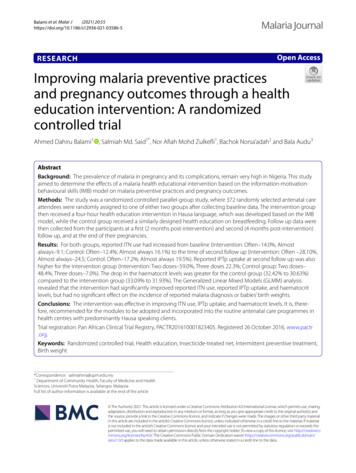
Transcription
(2021) 20:55Balami et al. Malar Jhttps://doi.org/10.1186/s12936-021-03586-5Malaria JournalOpen AccessRESEARCHImproving malaria preventive practicesand pregnancy outcomes through a healtheducation intervention: A randomizedcontrolled trialAhmed Dahiru Balami1 , Salmiah Md. Said1*, Nor Afiah Mohd Zulkefli1, Bachok Norsa’adah2 and Bala Audu3AbstractBackground: The prevalence of malaria in pregnancy and its complications, remain very high in Nigeria. This studyaimed to determine the effects of a malaria health educational intervention based on the information-motivationbehavioural skills (IMB) model on malaria preventive practices and pregnancy outcomes.Methods: The study was a randomized controlled parallel-group study, where 372 randomly selected antenatal careattendees were randomly assigned to one of either two groups after collecting baseline data. The intervention groupthen received a four-hour health education intervention in Hausa language, which was developed based on the IMBmodel, while the control group received a similarly designed health education on breastfeeding. Follow up data werethen collected from the participants at a first (2 months post-intervention) and second (4 months post-intervention)follow up, and at the end of their pregnancies.Results: For both groups, reported ITN use had increased from baseline (Intervention: Often–14.0%, Almostalways–9.1; Control: Often–12.4%; Almost always 16.1%) to the time of second follow up (Intervention: Often –28.10%,Almost always–24.5; Control: Often–17.2%; Almost always 19.5%). Reported IPTp uptake at second follow up was alsohigher for the intervention group (Intervention: Two doses–59.0%, Three doses 22.3%; Control group: Two doses–48.4%, Three doses–7.0%). The drop in the haematocrit levels was greater for the control group (32.42% to 30.63%)compared to the intervention group (33.09% to 31.93%). The Generalized Linear Mixed Models (GLMM) analysisrevealed that the intervention had significantly improved reported ITN use, reported IPTp uptake, and haematocritlevels, but had no significant effect on the incidence of reported malaria diagnosis or babies’ birth weights.Conclusions: The intervention was effective in improving ITN use, IPTp uptake, and haematocrit levels. It is, therefore, recommended for the modules to be adopted and incorporated into the routine antenatal care programmes inhealth centres with predominantly Hausa speaking clients.Trial registration: Pan African Clinical Trial Registry, PACTR201610001823405. Registered 26 October 2016, www.pactr .org.Keywords: Randomized controlled trial, Health education, Insecticide-treated net, Intermittent preventive treatment,Birth weight*Correspondence: salmiahms@upm.edu.my1Department of Community Health, Faculty of Medicine and HealthSciences, Universiti Putra Malaysia, Selangor, MalaysiaFull list of author information is available at the end of the article The Author(s) 2021. This article is licensed under a Creative Commons Attribution 4.0 International License, which permits use, sharing,adaptation, distribution and reproduction in any medium or format, as long as you give appropriate credit to the original author(s) andthe source, provide a link to the Creative Commons licence, and indicate if changes were made. The images or other third party materialin this article are included in the article’s Creative Commons licence, unless indicated otherwise in a credit line to the material. If materialis not included in the article’s Creative Commons licence and your intended use is not permitted by statutory regulation or exceeds thepermitted use, you will need to obtain permission directly from the copyright holder. To view a copy of this licence, visit http://creat iveco mmons .org/licen ses/by/4.0/. The Creative Commons Public Domain Dedication waiver (http://creat iveco mmons .org/publi cdoma in/zero/1.0/) applies to the data made available in this article, unless otherwise stated in a credit line to the data.
Balami et al. Malar J(2021) 20:55BackgroundMalaria infection remains endemic in many countriesincluding Nigeria [1], which contributed the largest percentage of cases (27%) to its global incidence in the year2016 [2]. Complications like anaemia [3, 4], abortion,[5, 6], stillbirth [7, 8], low birth weight [9, 10], and preterm delivery [7] could arise from malaria infection during pregnancy. The World Health Organization (WHO)recommends that all pregnant women living in malariaendemic regions of sub-Saharan Africa always sleepunder an insecticide-treated net (ITN), and take monthlydoses of intermittent preventive treatment in pregnancy(IPTp) with sulfadoxine-pyrimethamine (SP), startingfrom the second trimester of pregnancy [11]. Systematicreviews of trials have also shown that sleeping under anITN [12, 13] and taking IPTp [14, 15] greatly decreasethe risk of malaria infection and its complications duringpregnancy.In a study conducted from 2007 to 2008, 60% of randomly selected pregnant women in a tertiary healthcentre in Maiduguri, Nigeria, tested positive for malariaparasite at the time of booking for antenatal care [16],and 33.9% of them had placental parasitaemia at thetime of delivery [17]. In 2014, the prevalence of malariaparasitaemia among antenatal care attendees in thesame centre was 44.5% [18], and 48.1% in a secondary health centre in the same city [19]. Even the adverseevents which could occur as complications of malaria inpregnancy, have been highly prevalent in Maiduguri. Afour-year retrospective study (1995 to 1998) at a tertiarycentre in Maiduguri revealed a neonatal mortality rate of349 per 1,000 live births; and 62.1% of these deaths wereamong pre-term infants [20]. In 2012, out of 718 womenadmitted to the gynaecology ward in the three main public hospitals in Maiduguri, 17.5% had a previous historyof spontaneous abortion, 23.1% of which were attributedto infection/malaria and typhoid [6]. Over a four-yearperiod (2001 to 2004) in a tertiary hospital in Maiduguri,there were 23 stillbirths per 1,000 live births, out of 7,996deliveries [21]. Also in the same centre in 2009, out of854 pregnant women followed up to delivery, 16.9% hadlow birth weight babies [22].Despite the high prevalence of malaria infectionrecorded among pregnant women accessing health facilities in Maiduguri, the National Demographic and HealthSurvey of 2014 revealed that in Borno state, only 13.8%of pregnant women aged 15–49 years had slept underan ITN on the night before the survey, while only 13.9%had received any single dose of IPTp [23]. Following theBoko Haram insurgency, Maiduguri now has internallydisplaced persons (IDPs) from various local governmentareas of Borno and some neighbouring states [24]. Ofall the 36 states in Nigeria, Borno state has the highestPage 2 of 16number of IDPs, numbering 672,714, with Maidugurihosting 432,785, as at 2017 [25]. This is important, asbeing internally-displaced has been associated with manyhealth problems [26].Notwithstanding the high prevalence of malaria amongpregnant women in the region, the serious associatedcomplications, and the low compliance with prescribedpreventive measures, no interventions have been specifically developed for antenatal care attendees to help boosttheir level of compliance with these preventive practices, and by extension, reduce the incidence of malariainfection and its adverse consequences. A health education intervention on malaria, based on the ProtectionMotivation Theory (PMT) was effective in improvingboth self-efficacy and preventive practices [27], which isa pointer to the important role health theories are likelyto play in achieving a health behaviour change. However,the PMT fails to identify other environmental and cognitive factors that can affect attitude change [28].The Information-Motivation-Behavioural skills (IMB)theory on the other hand, conceptualizes the psychological determinants of performing health behaviours thathave an impact on health status. It was first developed tohelp guide the development of an intervention for HIVpreventive behaviours among students. It has three components, which are information about the health behaviours, motivation to carry out such behaviours, and therequisite skills for performing such behaviours [29].These appear relevant, as higher levels of knowledge onmalaria prevention alone, did not always translate toincreased use of bed nets [30]. The IMB model assertsthat information on malaria prevention, motivation,and behavioural skills are fundamental determinants ofmalaria preventive behaviour. Another advantage of theIMB model is that it can be culturally-tailored to suitlocal needs.The IMB model has proven valid in explaining a number of health behaviours. An IMB assessment of rationaldrug use behaviour among second-level hospital outpatients in Anhui, China, showed that this behaviour waspredicted by greater knowledge (β 0.25, p 0.001),more motivation (β 0.42, p 0.001), and better behavioural skills (β 0.16, p 0.001). In addition, there weresignificant indirect effects of greater knowledge (β 0.02,p 0.05) and more motivation (β 0.07, p 0.05) onbehaviour [31]. In community cultural centres in Isfahan city, Iran, logistic regression results demonstratedthat information (OR 1.071, p 0.001), motivation(OR 0.978, p 0.045) and behaviour skills (OR 1.033,p 0.001) predicted breast self- examination amongwomen aged 20–69 years [32]. For insecticide-treatednet use among pregnant women in a health facility inMaiduguri, Nigeria, Information and motivation were
Balami et al. Malar J(2021) 20:55significantly related to behaviour (r 0.22, p 0.001 andr 0.11, p 0.033 respectively), but behavioural skills didnot significantly relate to behaviour (r 0.03, p 0.278)[33]. With regards to consistent condom use (CCU)among unmarried female migrants in China, behaviouralskills had a positive effect (β 0.344, p 0.001), motivation had no direct influence, but indirectly, throughbehavioural skills (β 0.800, p 0.001), while information had no influence at all on CCU [34]. Similar findings were reported with CCU among transgender womenin Shenyang, China, were HIV-preventive motivation(β 0.823, p 0.001) and behavioural skills (β 0.979,p 0.004) were related to more frequent condom use,whereas HIV knowledge was unrelated to condom use(β 0.052, p 0.540) [35].In addition to its relevance in explaining health behaviours, numerous interventions guided by the IMBmodel were successful in achieving positive behaviouralchanges. A health education intervention based on theIMB model not only had large effects on the information (partial ἠ2 0.32) and motivation constructs (partial ἠ2 0.17), but also revealed a strong relationshipbetween constructs of the model (information, motivation and behavioural skills) and adherence to medicalrecommendations and health advices among coronaryartery bypass graft (CABG) surgery patients in Tehran,Iran [36]. A randomized controlled trial for HIV prevention among truck drivers in India in which participantswere classified into two groups (the intervention groupwhich underwent an IMB-based intervention workshop;and a control group that received an information-onlyworkshop) revealed evidence of effectiveness in improving attitude and increasing HIV preventive behaviouramong the intervention group [37]. The IMB model hasalso been used to predict not only behavioural change,but also the outcome of behavioural change. An intervention study among Puerto Rican Type II diabetes mellituspatients on exercise and dietary behaviour, revealed thatfor diet, information and motivation predicted behavioural skills, and behavioural skills predicted behaviour,but only behaviour predicted HbA1C control. For exercise, attitude predicted behavioural skills and behaviouralskills predicted behaviour; but behaviour in this case didnot predict HbA1C [38].Most of the prior studies with the IMB model have centred on improving preventive health behaviours, whichITN use and IPTp are not exceptions. Also, since the IMBmodel was useful in explaining ITN use among pregnantwomen [33], an intervention guided by it, is likely to besuccessful in boosting their compliance with the recommended malaria preventive measures. This study aimedto determine the effects of a health education intervention based on the information-motivation-behaviouralPage 3 of 16skills theory on malaria knowledge, motivation andbehavioural skills, as well as malaria preventive practicesand pregnancy outcomes. The intervention was successful in improving the primary outcomes, which are psychological constructs (malaria knowledge, motivationand behavioural skills) as already presented elsewhere[39]. This paper therefore, focuses on the secondary outcomes, which are behavioural (ITN use and IPTp uptake)and clinical factors (haematocrit, malaria infection, andpregnancy outcomes).MethodsStudy areaThe study area was Maiduguri, the Borno state capitalwhich is located in North-eastern Nigeria. Borno statelies between latitudes 10 30′ and 13 50′ north and longitudes 11.00 and 13 45′ east, with a total land area of69,435 km2. The climate varies according to the time ofthe year, with temperatures ranging from 25 C to 44 C,and an average annual rainfall of 613 mm [40]. Its population is reported to be 540,016 consisting of 282,409males and 257,607 females [41]. The study location whichwas the State Specialist Hospital, is one of the three secondary-level hospitals in Maiduguri, Bono State. It waschosen because it happens to be the biggest of them interms of size, man-power, and patient load. Its centrallocation in Maiduguri also makes it the most geographically accessible, to the majority of Maiduguri populace. The ante-natal care clinic is run as a unit under theDepartment of Obstetrics and Gynaecology, and is runfrom Mondays to Fridays. Mondays are reserved for antenatal care bookings, while follow-up visits are conductedon the other days. Each antenatal booking clinic sessionhas an average load of approximately a hundred clients.Antenatal booking at the hospital’s clinic is open to allpregnant women, irrespective of their gestational ages,and with no requirement for referral letters from othercentres. Routine antenatal health education is given bythe midwives at the waiting hall, before antenatal careconsultations start. These talks given are not structured,and cut across issues of hygiene, proper nutrition, breastfeeding, malaria prevention and any health issue deemedrelevant by the staff.Study design and study populationThe study was a double-blind parallel-group randomizedcontrolled trial guided by the CONSORT Statement [42].Participants were randomly selected from the ante-natalcare attendees, and then randomly assigned to either theintervention or control group (with an equal numberof participants in each group). The intervention groupreceived the IMB-based health education intervention on malaria, while the control group received health
Balami et al. Malar J(2021) 20:55education on breastfeeding. The study population waspregnant women attending the State Specialist Hospital,Maiduguri, for their ante-natal care.Those who do not understand the Hausa language wereexcluded because the intervention was prepared anddelivered in the Hausa language. Also excluded were participants who had a history of medical conditions whichcould interfere with the study outcomes like hypertension, pre-eclampsia or eclampsia [43–45], diabetes [46,47] and a history of per vaginal bleeding in current pregnancy [48]. Substituting the results of post-interventionITN use from a previous study ( p1 0.38, q1 0.62, p2 0.21, q2 0.79) [49] into the sample size formula forrandomized controlled trials with binary outcomes [50],with a minimum difference of 10% to be detected, at 95%level of significance and power of 80%, gave a minimumrequired sample size of 346. This shows that the totalnumber of participants–372–for the primary outcomevariables [39] is also adequate for the secondary variables.RandomizationRandom assignment of the participants to either theintervention or control group, was done on the same daythe participants were selected into the study. It was however performed after baseline data had been collected.Sequence generationThe permuted block randomization technique was used.Permuted blocks of four (each containing two interventions and two controls), containing all the six possiblecombinations (AABB, BBAA, ABBA, BAAB, ABAB,BABA) were generated using the random function inMicrosoft Excel 2013.Allocation concealment mechanismThe sequences generated were then placed insideopaque envelopes and sealed by the medical records’staff who generated them. The envelopes were also serially numbered from the outside, to guide those doing theallocation.ImplementationThe sequence generation was performed by a trainedstaff of the hospital’s Medical Records Department, whowas not part of any of the other research processes. Twoother staff of the antenatal clinic worked independentlyto assign groups to the participants. The first staff serially handed over the envelopes to the participants without opening, then directed them to the second staff. Thesecond staff then opened the envelopes, informed themof the day to come for their health education session(based on the group to which they belonged), and thenPage 4 of 16documented their respective groups on a sheet provided.Each participant was then given a hand card, which carried their bio-data and serial numbers. The hand cardalso contained a short note indicating that they had beenenrolled into a follow-up study and requesting of theattending physician or nurse to kindly complete the postnatal findings as indicated on the card.BlindingThe study was double-blinded, as participants andassessors (enumerators) were blinded to the assignedinterventions. The list of assignments was then kept confidential by the staff who documented the participants’allocations. This staff was only aware of the group coding(A and B), but unaware of the interventions assigned tothem. To ensure blinding of the participants, the groupsthey belonged to, were not indicated on their cards. Thesubsequent clinic appointment dates for the two groupswere set on different days, to minimize contamination.The enumerators were blinded, as they were not involvedin any of the processes of group allocation, or delivery ofthe intervention.Development of the health educational interventionmodulesFor the malaria health education intervention, the information sources for developing the modules were: theNational Guidelines and Strategies for Malaria Prevention and Control During Pregnancy, a publication ofthe Nigerian Federal Ministry of Health [50]; WHOpublished materials [11, 51]; a publication of the GlobalHealth Learning Centre on Malaria in Pregnancy [52];and other publications from studies carried out in Nigeria. It was developed based on the Information-Motivation-Behavioural Skills theory [29], using local scenariosfor demonstration purposes. The breastfeeding moduleswere developed from the following sources: NationalPolicy on Infant and Young Child Feeding in Nigeria [53];Lactation Management Self-Study Modules, Level I [54]and other studies conducted in Nigeria on breastfeedingpractices. The items extracted from these sources werecompiled to follow a similar pattern with that for themalaria health education intervention. Being prospectivemothers, health education on breastfeeding was relevantto them, and as such, had the potentials of serving as apotent placebo intervention.Structure of the malaria health educational interventionmodulesThe intervention consisted of four modules, coveringeach of the constructs of the IMB model as presented in
Balami et al. Malar J(2021) 20:55Page 5 of 16Table 1. The first and second modules covered the information construct, the third module covered the motivation construct, while the fourth module covered thebehavioural skills construct.The first module was titled ‘Understanding Malariain Pregnancy’. This module gave a general discussion onmalaria in pregnancy, at the end of which the participantswere expected to be able to know what causes malaria;its mode of transmission; its signs and symptoms; itscomplications during pregnancy; and how it can be prevented. This section was delivered basically throughlectures. The second module was titled, ‘The Main Preventive Measures for Malaria in Pregnancy’ which introduced the two most important preventive measures formalaria during pregnancy (TN use and IPTp uptake).This module discussed the importance and efficacy ofthese preventive measures, as well as success storiesof these measures as reported in prior studies. Participants were expected to be able to highlight the protectiveimportance of IPTp and ITN at the end of this section.This section was also delivered through lectures.The third module was titled, ‘Motivation for MalariaPrevention during Pregnancy’, and it dwelt on motivating the participants to adopt these protective measures.This module was designed to guide an interactive session,for misconceptions and other possible deterrent factorsto be addressed interactively. The facilitator together withthe participants was to brainstorm and proffer possibleways of overcoming those deterrent factors. At the end ofthis session, participants were expected to be convincedof the efficacy and safety of these preventive measures,and also motivated to carry them out. The fourth moduletitled, ‘Insecticide Treated Net and Fansidar’, focused onempowering the participants. They were to be practically shown how to hang and care for their insecticidalnets, and how to look out for defects in their nets, andhow to repair them. They were also taught about the timings, indications and contra-indications for IPTp, andalso educated on how to take their drugs. Their level ofself-efficacy was to be assessed at a group level, and collectively, goals were set to achieve better adherence tothese malaria preventive measures. There were evaluation questions at the end of Modules 1, 2 and 4.Structure of the breastfeeding health educationalintervention modulesThe placebo intervention was made to comprise of threemodules, each covering a construct of the IMB model.As presented in Table 2, the first module covered theinformation construct, the second module covered themotivation construct, and the third module covered thebehavioural skills construct. The first module titled, ‘AnOverview of Breastfeeding’ had two sections: the firstsection was on the benefits of breastfeeding and the consequences of not breastfeeding; while the second sectiondiscussed the practices to avoid during breastfeeding,alternatives to breastfeeding, and challenges associatedwith breastfeeding, such as sore nipples, low milk supply and breast engorgement. The second module titled,‘Motivation on Breastfeeding’ contained a list of misconceptions and other deterrent factors for exclusive breastfeeding as identified in previous studies. These were tobe discussed and brainstormed by the participants underthe facilitator’s guidance to come up with solutions. TheTable 1 Tabular illustration of the malaria intervention modules by construct and contentsTheory Construct Module and StrategyContentsEstimated timeInformationModules 1 and Module 2 (Lectures)Transmission; Clinical features; Complications; Preventionmeasures30 min and 30 minMotivationModule 3 (Interactive discussion; Brainstorming) Participants’ experiences and those of other pregnantwomen1 h 30 minBehavioural skillsModule 4 (Lectures; Videos; Demonstrations)1 h 30 minEvaluation of self-efficacy for taking IPTp-SP and using ITN;Goal settingTable 2 Tabular illustration of the breastfeeding intervention modules by construct and contentsTheory Construct Module and StrategyContentsEstimated timeInformationModule 1 (Lectures)Benefits of breastfeeding,Consequences of not breast feedingProblems associated with breastfeeding30 min1hMotivationModule 2 (Interactive discussion; Brainstorming) Participants’ experiences and those of other pregnant women 1 h 30 minBehavioural skillsModule 3 (Lectures; Videos; Demonstrations)Practical demonstrations of breastfeeding techniques; expres- 1 hoursion of breast milk
Balami et al. Malar J(2021) 20:55third module titled, ‘Practical Session’ was for breastfeeding procedures to be demonstrated practically usingmodels, as well as video demonstrations to be shown tothe participants.Quality control of the health educational interventionsThis entailed appraising the modules for accuracy, relevance and comprehensibility, as well as giving the facilitator adequate training on the modules.Quality control of the module contentsThe modules for the intervention group as well as thecontrol group were appraised for their contents and relevance by expert teams. For the malaria health education intervention modules, the team comprised of threepublic health specialists, an obstetrics and gynaecologyspecialist, a health educator, and a midwife; while theappraisal team for the modules on breastfeeding comprised of three public health specialists, a health educator, and a paediatric nurse. Both interventions werepre-tested with a sample of twenty-five pregnant womenfrom the same hospital, who were not part of the study.Feedback was then obtained from the experts, as well asthe participants, and appropriate modifications and corrections were effected on the modules.Training of the module facilitatorOne facilitator who was a midwife was chosen to deliverthe modules at all the health education sessions for bothgroups. For each of the two interventions, the facilitator received two sessions of one-on-one training by theresearcher. The first session lasted about four hours long,during which the contents of the modules, and how todeliver them within their limits were treated. A revisionsession was then held again in a similar way after themodule had been revised (after the pre-testing).Delivery of the malaria IMB‑based malaria healtheducational interventionThe interventions were given a week after baseline datahad been collected. As suggested by McMillan, deliveryof educational interventions should be in modes thatare consistent with what is used in practice [55], and assuch, they were given at a group level, and in a single session, with each session having around fifty participants.The module was delivered by the facilitator (a midwifenurse), to eliminate experimenter effects. The facilitatorwas blinded to the objectives of the study, and deliveryof the module was also closely monitored and supervisedby the researcher, while giving necessary feed-back to thefacilitator to ensure that the module was strictly followedwithout straying. The facilitator went through all the fourmodules, while actively engaging the participants. ThePage 6 of 16durations were approximately 30 min, 30 min, 1 h 30 min,and 1 h 30 min, for modules 1, 2, 3 and 4 respectively,with breaks of about 10 to 15 min between modules.Each participant was given the chance to demonstratewhat she had learnt, and corrective feed-back was given.Delivery of the breastfeeding health educationinterventionThe health education modules on breastfeeding weredelivered by the same midwife who gave the malariahealth education. The total duration of the session wasalso around four hours, and the delivery was of similar methodology to that of the malaria health educationmodules, comprising of lectures with power-point presentations, videos, discussions, and practical sessions.A paediatric nurse helped out with the demonstrationsusing models. The delivery was also strictly monitored toensure strict adherence to the module and its contents,without straying.Follow‑up of participantsAfter collecting baseline data, randomization, and delivery of the intervention, participants were then followedup. Follow-up data were collected using the same questionnaire, at 2-months post-intervention and 4-monthspost-intervention. Participants were also requested toalways carry their hand cards with them each time theyvisited the hospital, especially when they were going fordelivery, or in the case of home delivery, to present to thehospital immediately. Data on babies’ birth weights andpregnancy outcomes were filled on the hand card by theattending physician or nurse, which participants submitted back after their deliveries. For each visit, compensation for transport fare was given to each participant.VariablesThe independent variable in this study was group,whereas the dependent variables were reported ITN use,reported IPTp uptake, reported malaria diagnosis, haematocrit, pregnancy outcome, and babies’ birth weights.Other variables which were considered potential confounding factors in this study, included ethnicity, familytype, type of residence, educational status, occupationalstatus, income level, age at first marriage, gravidity; parity, period of amenorrhoea, history of a previous pretermdelivery, history of a previous miscarriage, time, andgroup-time interaction.Group, was defined as the study arm a participantbelonged to, which was either the intervention or control group. Time meant the three time points, frombaseline to 2-months post-intervention, to 4-monthspost-intervention, while group-time interaction entailedthe effect of the intervention with regards to time.
Balami et al. Malar J(2021) 20:55Reported malaria diagnosis was said to be positive if aparticipant reported that she had been diagnosed withmalaria in a health centre after having had a blood testdone. A monogamous family was defined as one withone husband and one wife, while a polygamous familywas defined as one in which the husband had more thanone wife [56]. An internally displaced person (IDP) wasdefined as a Nigerian who had been displaced from hertown of residence, but not outside the country, as a
Balami et al. Malar J Page 6 of 16 eedingprocedurestobedemonstratedpracticallyusing models .
